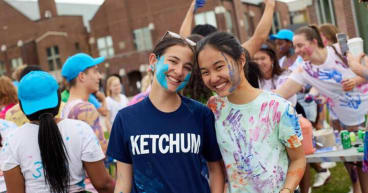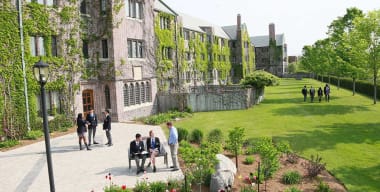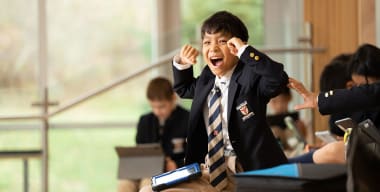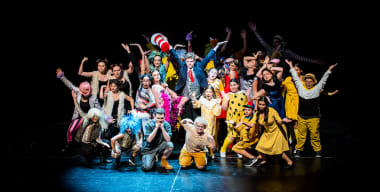The mistress of one home leads me to the nearby store, where seven-year-old clerks and cooks prepare and sell food. A handful of grass and dandelions is a salad; berries on a stick is pie; some mud is chocolate cake. I like chocolate, but today I am on a diet so I ask what kind of dressing is on the salad. The clerk holds her head to the side, wondering, then declares it is a secret recipe. I suggest it looks like it has mayonnaise in it, but the clerk is firm: It is a secret. I ask how much the salad is. "Two," I am told. I don't have any money, but that doesn't matter. The clerk goes out and gathers some pine cones. Apparently this is the ancient currency of this forest. I pay, and they watch appreciatively when I "eat" my salad and compliment the cook. I return the dandelions through the back door, because another buyer is at the "counter," but I do stuff a couple of pine cones in my pocket for my next visit.

The world of children is the world of imagination. It is overflowing with creative juices, ingenuity, inventiveness and it is serious business. All of us were naturally like this. It is part of the human design. Imagination is our birthright.
Yet most adults grow up thinking they are not creative. Imagination is frequently assigned (wrongly) to the closeted realms of the arts and seen as largely the private property of artists. The development of the imagination in schools is often treated as frivolous, a waste of resources, antithetical to the development of thinking or to modern needs for productivity, childish or construed as a detachment from reality, and definitely not even remotely connected to the overall development of intelligence.
In looking deeper at imagination's role in forming intelligence, however, we uncover traces of an incredibly powerful capacity that is greatly valued in almost every aspect of life, and that is designed to help us mature, change, cope and thrive as we evolve.
We have artificially separated imagination from intelligence–as if imagination is an add-on to a real educational experience–and from the development of abstract thinking, social/emotional capacities and physical development. Everything is compartmentalized in our school systems, betraying the true relationship between our multiple intelligences and imagination. These capacities are highly integrated and complementary.
Imaginative play and fantasy in children disappear around the eighth, ninth or tenth year. Houses in the pine forest are given over to younger children; the tooth fairy is really mom or dad; imaginary friends go away. For some educators, this reinforces the belief that imagination is childish and development of thinking is preferable. Some educators and parents even go out of their way to "correct" imaginative play in young children, injecting it with adult explanations of reality, as if imagination indicated immaturity or mental illness from which children needs to be rescued.
But the imagination doesn't disappear; it goes undercover. And a profound drama begins to unfold within the human being and the mind.
Around the age of 10, an enzyme in the brain starts pruning the weak links in the neuronets. Nearly two-thirds of neuronets are culled as the brain is shaped for more specialized functions leading toward the development of abstract thinking. The brain's Right Hemisphere (RH) and Left Hemisphere (LH) begin to work more independently. The imaginative, nonverbal, spatial, intuitive, analogic, sensate capacities of the RH work through our senses and feelings to investigate the world. This information is passed on to the LH, which specializes in forming abstract concepts, language development, logic and mathematics.
There appears to be a great partnership between RH Imagination and LH Logic, but it becomes more and more difficult as children move closer to puberty, when Logic begins to reject the activity of Imagination because we take comfort in our known ideas. Logic will even go as far as creating feelings of crisis and panic within us to stop imaginative activity.
Betty Edwards in her classic text Drawing on the Right Side of the Brain wonderfully describes this crisis point. She uses the example of children who suddenly stop drawing as they approach puberty. Asked to explain, they criticize themselves and their abilities, claiming they are "bad at drawing." Edwards observed that if asked to sketch a real object sitting on a table in front of them, children had strong negative reactions that could include physical symptoms of nausea, irritation, fatigue, stomach pains, cold sweats, criticalness and an urge to flee.
Using brain research, Edwards pinpoints the cause of this crisis as a struggle between the left and right hemispheres, and goes on to show how simple techniques can transcend this inner struggle and allow students, within days, to move from drawing childlike images to more realistic, complex artistic renderings.
However, this is not about art. It is about how we transform childlike concepts into more mature ideas through the healthy development of abstract thought. There are myriad examples of adults throughout history in every discipline and vocation who have been so stuck in their ideas that they were blind to the reality around them, sometimes at great cost.
To date, we have left the development of Imagination to the forces of evolution. The wise design of nature brings gifts to help us from becoming stuck in our world of preconceived ideas. Puberty with its awakening of our sensuality and social awareness, opens the door for Imagination and exploration. It is, however, a hard time for adolescents, and we see in their argumentativeness an exchange of ideas that reform precious concepts to a more mature level by having the rough edges of immature ideas challenged and knocked off.
As we mature, we learn coping skills, if we are lucky, to keep our preconceived notions from getting the better of us. We can learn to adapt, grow and function at fairly sophisticated and mature levels.
However, the resistance and tyrannical rule of Logic never really goes away. It tries to protect itself by joining groups of like-minded people, creating predictable environments, clinging to fundamental truths that shall never change, settling down in a comfortable place that demands little change, offers few surprises and shelters us from the persistent work of Imagination. Everything seems to go smoothly until mid-life and our dawning sense of mortality, which is again nature's gift to help us mature.
This unconscious evolving of our intelligence creates in us a reactive intelligence, based around our desire to survive change and the unexpected. It changes only as much as needed to get by: "What do I need to know to pass the test?"
Educators today must ask, Is this good enough? Business leaders, environmentalists, politicians, academics and scientists all tell us, no. We need more creativity, more ingenuity, more vision–more imagination–and we need it now. Albert Einstein, remarking on the context of his day said, "The unleashed power of the atom has changed everything save our modes of thinking and we thus drift toward unparalleled catastrophe."
We need a new way of thinking, a proactive intelligence, fuelled by a love of learning, not constrained by fear of the unknown. We need educational models that foster proactive intelligence in students. Luckily, it is in our reach. It is being accomplished by schools active in providing alternative education. On a larger scale, cultivating proactive intelligence in our students requires shifts in perception, practice and priority.
The first shift, in perception, involves the subtleties of the development of imagination and uses aspects of the curriculum to exercise our imagination's muscle. The open-ended processes of arts and crafts are excellent tools. It is the process of artistic activity that helps shape the development of intelligence. Not every kid needs to be a great artist but every kid should be given the skills to manage the evolutionary change taking place within them.
Second is a shift in practice that brings together the two sides of the brain by integrating the arts and crafts with the core academic subjects that specialize in the training of analysis, logic and concept formation. To prevent Logic from building too strong a defence against Imagination's activity, this integration must happen early and continue all the way through high school (ideally through university, since the prefrontal lobes of the brain continue to developuntil around the age of 23). Children gain increased capacities to think dynamically, and develop all aspects of their intelligence. Studies have shown that students involved in the arts achieve significantly higher results on core academic subjects as well, which should be no surprise.
A third shift involves how we teach concepts. Do we give children experiences to let Imagination explore (phenomenology), or do we feed Logic pre-formed concepts? The modern preference, and priority, is to do the latter, which inoculates our children against imagination and proactive intelligence by injecting concepts that are "dead"–not formed out of Imagination experience or open to more information. A concept built up through the use of Imagination is flexible and open to new data, capable of being changed to accommodate further insight, always taking us closer to what is true.
Proactive intelligence is a gift that keeps on giving. Betty Edwards' students shocked themselves with their ability to create incredible drawings in such a short amount of time. When they saw what they could do, they wanted to draw more. In the same way, proactive intelligence unleashes a fire for learning in the heart of our children. They carry their passion for learning to all subjects. But most importantly for our time, it permeates children with a sense of hope and confidence, that there is no problem too big for them to take on.
Under the forest of sweeping pines, we see the power of human beings to recreate worlds with ease. As educators, it is our high task to help children carry these capacities undaunted into adulthood. William Butler Yeats remarked, "Education is not the filling of a pail, but the lighting of a fire." If we can manage to light the fire of proactive intelligence in our students, the world will receive Promethean fire a second time, and we will leave the earth a better place than we found it.









